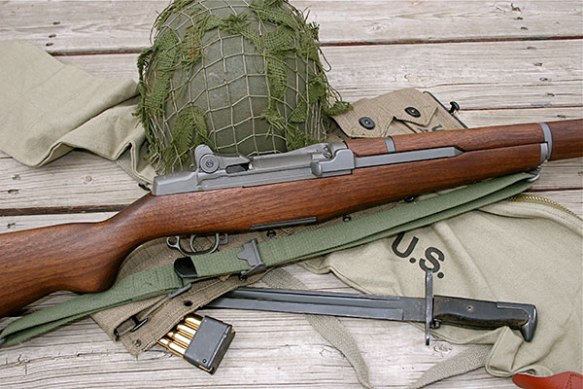In the Postwar analysis of battle experience at the end of World War I, when the Germans collapsed and the front opened up, the US Army Ordnance Department became concerned over the weight of ammunition carried as part of the soldier’s basic load. They began to conduct a series of tests on using a smaller caliber round to allow the soldier to carry more rounds. The original rifle designed by Garand was in, I believe, .275 caliber or the like. The Infantry Board was originally enthusiastic about this and so a series of tests were conducted against animals, the so-called “Pig” and “Sheep” boards. These boards came to the conclusion that the new and smaller round was essentially as lethal as the older .30-’06.
General Douglas MacArthur, as Chief of Staff, had to find funding for the Garand design but ran up against Depression-era Congressional reluctance to fund development and factory preparation. One point raised by many Congressmen was the possession in US war stocks of ten million or more rounds of .30-’06 ammunition left over from the First War. MacArthur was anxious to get funding for factory preparation — that is a process by which the Army tells a manufacturer that it might need to order a gizmo of a given design, and here is some money to figure out how to make this in your factory and to prepare jigs and the like for production. The compromise reached was to retain the .30-’06 round but to get factories ready to make the M1 in that caliber when the need arose. (This was survival money for many of these companies, as they were often closed-down factories at the time with only a couple of employees left.)
So, MacArthur directed the Chief of Ordnance to have Garand redesign the M1 in .30-’06, and the rest is history.
MacArthur’s predecessor, Hines, refused to even consider any new rifle and was unwilling to press the point with the pacifist President Hoover. MacArthur pressed the point and so the M1 was able to go into production in the early days of rearmament.
Garand originally designed his rifle for this smaller cartridge. Congress yawned and the program sat on its hind legs for a couple of years.
In the early 1930’s, the Infantry School rethought doctrine under the leadership of Marshall and Bradley and Stilwell. Marshall reduced the reality of the Army to “move, shoot, and communicate” (soon reduced by the Command & General Staff School to, “scoot, shoot, and toot”, perhaps with a layer of sarcasm) and pushed for mobile warfare, especially with his repugnance for formal Operations Orders and his development of what were soon known as “frag orders”. This change was intended to keep the Army out of the trenches but I have never read that these worthies saw the need for any major change in equipment or ordnance: they just wanted to keep the Army from being confronted with that horrible half-mile stretch of churned up, shot-over mud from one trench line to the next, which Marshall saw as the major obstacle to mobile warfare as, in the lights of the early 1930’s, once the trench lines came into play, then there was no way to resupply an advance beyond marginal captures. Marshall and Bradley and Stilwell felt that the Army had to keep moving. To that end, the Infantry School suggested the adoption of a semi-automatic rifle to increase the firepower of the squad but said nothing as to whether it would be magazine or clip fed.
This all was on Douglas MacArthur’s desk when he became Chief of Staff. In 1933, MacArthur and the Secretary of the Army met with a number of Congressional leaders to see what could be done. The Congressmen refused to adopt a new caliber and insisted that any new rifle retain the .30-’06 round, of which the Army then had millions of rounds in storage in the US, the Canal Zone, Alaska, Puerto Rico, Hawaii, and the Philippines. The Congressmen authorized the War Department to adopt a new standard rifle and then, after some schmoozing from MacArthur and, later, Roosevelt, agreed to enlarged “development grants” which allowed several companies to be able to produce the M1 on short order (say, 9 months as opposed to two years). Regular production of the M1 chambered in .30-’06 was thus established by 1934 but production was years away, though the Army was then able to send blue prints of the weapon and detailed instructions on how to make it to a number of companies. (Congress was immensely short-sighted between the Wars but their willingness to fund mobilization and development costs is something which never seems to be remembered by the critics of the institution at this time.)
